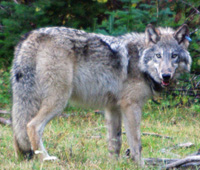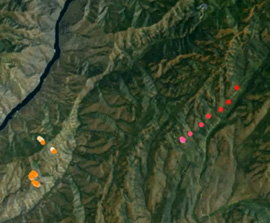|
MARCH 6, 2016
|
 |
 |
|
|
Hour 1 |
 |
Hour 2 |
 |
|
|
Wolf Livestock
Interaction |
|
COMING TO A CATTLE RANCH NEAR YOU
www.OregonState.edu
|
|
'AKA - Silence of the Cows Part 2' |
|
Our guest: John Williams |
John
Williams is an Associate Professor in the
Department of Rangeland Resources at Oregon
State University working as a natural
resources Extension agent in Wallowa County.
He holds a B.S. degree in animal science and
a Master of Agriculture in Animal Science,
Rangeland Resources and Agricultural
Resource Economics. He ranched for 15 years
and has been an Extension agent for 29
years. He has lived in Wallowa County for 22
years. He lives with his wife Eileen on 10
acres where they have sheep, cattle and
horses. They have two grown children.
During those years he has helped the county
with several public policy issues such as
the ESA listings of the listing of the Snake
River Chinook Salmon and the wolf. He has
helped the county develop the Natural
Resource Advisory Committee which leads the
effort in the county to make the best
decisions possible about natural resource
issues. It also works to aid the federal and
state agencies in the development of
appropriate policies and decisions when it
involves local lands, animals or people.
For the past 5 years John has been a member
of the research team studying the impacts of
the presence of wolves on livestock. This
multi-state study includes Oregon State
University, University of Idaho, The
Agricultural Research Service and 8 ranchers
in both Idaho and Oregon.
|
|
|
|
|
 |
Oregon State University Special
Research Report: Impact of previous exposure to wolves on
temperament and physiological responses of beef cattle following a
simulated wolf encounter
Synopsis: The simulated wolf encounter increased excitability and
fear-related stress responses in cows previously exposed to wolves,
but not in cows unfamiliar with this predator.
Special Report - Wolf predation temperam[...]
pdf [.6 MB] |
|
|
|
 |
Wolf Attack- a Cow Man’s Worst
Nightmare
Wolves attacked and stampeded 250 head of very pregnant cows (start
date March 1) on the Birkmaier private land on Crow Creek pass
February 12, 2015. The cows were wintering on the open bunch grass
range receiving 1/2 feed of alfalfa hay. This 1700 acre piece of
land is about 10 miles NE of Joseph These cows were to be moved to
the Birkmaier home ranch at the mouth of Crow Creek the last of
February (ranch is about 20 miles north).
With no warning from agency people, who normally warn producers of
wolves in the area, the wolves attacked in the night. The herd split
into three groups, one group of about 70 cows went east, running in
total panic, obliterating several barb wire fences. These cows ran
about 2 miles to the Zumwalt road then south and west about 5 miles
down the OK gulch roa
Mack Birkmaier wolf cattle story editori[...]
pdf [.4 MB] |
|
|
|
 |
Estimates of Economic Losses to Stock
Growers due to the Presence of Wolves in North Eastern Oregon
While any benefits associated with the introduction of wolves in NE
Oregon are primarily nonmarket based, difficult to quantify and
widely distributed among possibly millions of people who value
wolves, at least some of the costs of introducing wolves in NE
Oregon are market based, can be accurately estimated and are focused
on the producers and the local economies to which they contribute.
North Eastern Oregon includes 5 counties. The livestock producer is
on the front line of the wolf/livestock conflict and the losses to
the producer both increase the producer’s direct costs of doing
business and reduces the revenue received in those businesses
thereby negatively affecting both sides of their balance sheet. The
following economic assessment is based on the assumption that the
ranches
Estimates of Economic Losses to Stock Gr[...]
pdf [155 KB] |
|
|
|
|
Preliminary Estimates of Potential Economic Losses to
Stock Growers due to the Presence of Wolves in North Eastern Oregon |
|
READ FULL REPORT:
Preliminary_Estimates_of_Potential_Economic_Losses_to_Stock_Growers.pdf |
|
Abstract |
|
While any benefits
associated with the introduction of wolves in NE Oregon are
primarily nonmarket based, difficult to quantify and widely
distributed among possibly millions of people who value
wolves, at least some of the costs of introducing wolves in
NE Oregon are market based, can be accurately estimated and
are focused on the producers and the local economies to
which they contribute. North Eastern Oregon includes 5
counties. The livestock producer is on the front line of the
wolf/livestock conflict and the losses to the producer both
increase the producer’s direct costs of doing business and
reduces the revenue received in those businesses thereby
negatively affecting both sides of their balance sheet. The
following economic assessment is based on the assumption
that the ranches are in areas where wolves have reached full
occupancy and that the cattle are in areas where wolves are
present through all seasons of the year. |
|
|
Wolf Cattle
Interaction Study |
|
READ FULL REPORT:
Wolf_Research_report_2012_October_22.pdf |
|
The reintroduction of wolves
into Central Idaho and the Yellowstone National Park and their
subsequent dispersal throughout the northern Rocky Mountains has led
to increased livestock depredation and conflict with livestock
producers (USFW 2011). Stock growers report both direct losses as
injured or killed cattle, sheep, horses, and dogs, as well as
indirect livestock losses from increased stress resulting in lower
conception rates, higher incidence of respiratory and other
diseases, lower body condition scores, and changes in temperament
resulting in more difficult trailing and handling (Kluever et al.
2008, Lima and Dill 1990, Howery and Deliberto 2004, Williams 2010).
Herd management costs also increase with wolves because producers
need to check on animals more frequently, spend more time doctoring
injured stock, and find animals scattered during predation events so
they can be removed to safe locations (Williams 2010). Removal of
cattle generally results in disruption of annual grazing plans and
higher forage costs.
It has been suggested that
wolves may create a “landscape of fear” that alters landscape use
and preferred habitats because of the threat of predation (Manning
et al. 2009, Kauffman et al. 2010). If livestock alter their
resource use or the extent of their dispersal across the landscape
because of wolves, currently preferred sites may not be grazed and
the carrying capacity of the land could be reduced. Ranchers also
report that livestock group into larger herds when predation is
frequent which concentrate cattle making grazing management more
difficult.
Research that examines
wolf effects on wildlife populations is fairly common (Laundre et
al. 2001, Garrott et al. 2005, Gude et al 2006, Creel et al. 2005,
Muhly et al. 2010, Hebblewhite et al. 2002, Vucetich et al. 2005)
but studies focused on wolf impacts on domestic livestock resource
selection, behavior and ranch-level economics are rare (Muhly et al.
2010, Laporte et al. 2010, Oakleaf 2003, Bradley and Pletscher 2005,
Rambler 2011). Our study was designed to document the effect of wolf
predation on cattle behavior, landscape use patterns, and resource
selection by comparing areas with high wolf densities against those
with low wolf densities. This study was also designed to generate
baseline information on cattle spatial behavior before wolves become
common on landscapes where they currently are rare. |
|
|
|
Wolf tracking
videos or "Cow Movies" |
|
 |
|
GRAY WOLF OR7 |
An efficient and
effective way of viewing GPS tracking data is by creating “cow
movies” in which animal GPS positions are sequentially plotted on a
background map (e.g., aerial photograph). These movies or video
files typically show current animal positions as bright points that
then fade and disappear leaving a “tail” of fading points as the
succeeding positions continue to be plotted. The GPS positions
plotted in these video files are time-stamped with Universal
Date/Time so spatial relationships, activities, or specific events
can be identified and, if needed, the
 original
data sets reexamined. The videos created from each site and year can
be viewed at any desired frame rate, stopped, and backed up as
necessary to gain insight as to herding behavior, resource use
pattern, and by combining wolf and cattle data, wolf-cattle
interactions. Because file size can become very large with long
duration data sets, we break our observation periods into units of
10 days or less. An example of this type of data can be viewed at:
http://oregonstate.edu/dept/range/node/49149 original
data sets reexamined. The videos created from each site and year can
be viewed at any desired frame rate, stopped, and backed up as
necessary to gain insight as to herding behavior, resource use
pattern, and by combining wolf and cattle data, wolf-cattle
interactions. Because file size can become very large with long
duration data sets, we break our observation periods into units of
10 days or less. An example of this type of data can be viewed at:
http://oregonstate.edu/dept/range/node/49149 |
|
|
|
Dealing with Wolves
in Oregon, October 6, 2011 |
|
READ FULL REPORT:
Wolves_in_Oregon_unlisted_Oct
10_generic.pdf |
|
With the dispersal of wolves
from Northeastern Oregon to several new places throughout the
eastern half of the state, citizens need to know what is legal, whom
to contact and what procedures you may need to follow if you
encounter a wolf. An additional concern is that the wolves in Oregon
can be found in close proximity to homes, calving operations, barns
and other places where people work, live and play,
The wolf is currently
listed as Endangered under the Oregon ESA. It has been delisted by
the Federal Government in the portion of Oregon that lies east of
Hwy 395 from the Washington line to Burns, then south along Hwy 78
to Burns Junction, and south along Hwy 95 to the Nevada border. West
of that line wolves are listed as threatened under the federal ESA,
however, management of the wolves is very similar and contacts below
would be the same. |
|
|
|
Video:
Wolf Hunting Tactics |
|
|
|
|
|
Video:
Crying Wolf Movie Trailer |
|
|
|
Purchase this movie to show your group @ CryingWolfMovie.com |
|
|
|
|
|
Websites and
material mentioned on
today's program: |
|
www.OregonState.edu |
|
Preliminary_Estimates_of_Potential_Economic_Losses_to_Stock_Growers.pdf |
|
http://anrs.oregonstate.edu/content/wolf-and-cattle-interactions |
|
Wolves_in_Oregon_unlisted_Oct 10_generic.pdf |
|
|
|
|
|
|
|
|
|
|
|
|
|
|
|
INDEX OF RADIO
SHOWS |
|
SEARCH |
|
|
WE THE PEOPLE RADIO |
|
|
|
|
|
|